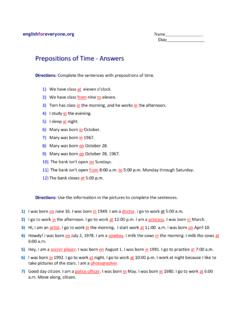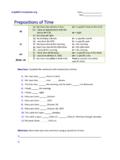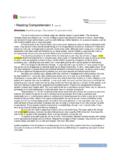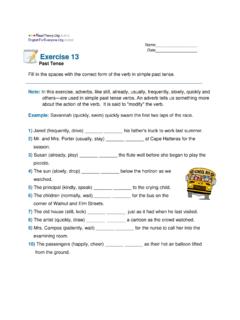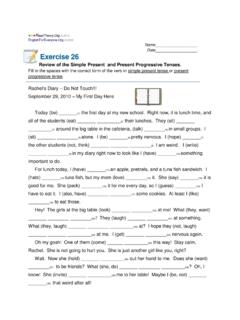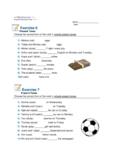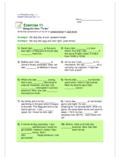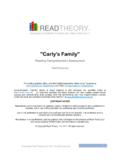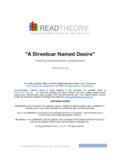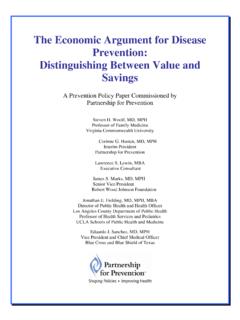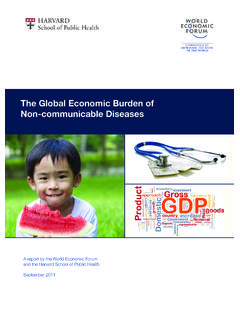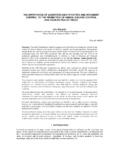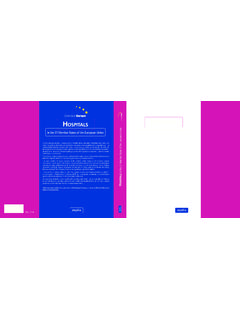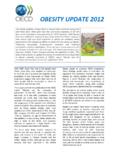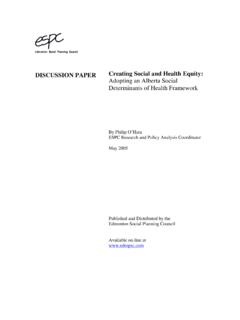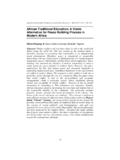Transcription of RReeaaddiinngg nCCoommpprreehheenssiioonn 44 Level 11
1 READTHEORY. Name_____. Date_____. Reading Comprehension 4 Level 11. Directions: Read the passage. Then answer the questions below. According to some estimates, if we could compile the amount of food, land, water, and energy used to raise the 10 billion animals slaughtered each year for meat, we could use those resources to feed every single starving person on earth. The majority of these resources are depleted by concentrated animal feeding operations (CAFOs). CAFOs are factory farms that mass-produce livestock harming animals, the environment, and humans in the process. It is true that these farming methods provide an abundant source of food and employ thousands of workers across the country. However, CAFOs should be placed under more stringent restrictions because of their unfair treatment of animals and the harm they do to both the environment and humans. One of the key controversies surrounding factory farms is animal rights. Factory farms raise livestock indoors, as opposed to allowing the animals to graze in fields and pastures.
2 The farmers favor this overcrowded environment because it maximizes profits. Providing less space for the animals costs less money; filling pens to their maximum capacity ensures that no space is wasted. Consequently, animal pens are often so small that larger animals cannot lie down or turn around. In some cases, these small cages are beneficial for more than just maximizing capacity: calves, for example, do not gain muscle mass in this environment. This keeps their meat more tender, which makes it more attractive to consumers. Livestock in CAFOs are often found living in their own urine and feces, stimulating the spread of diseases such as avian flu, foot and mouth disease, and mad cow disease among other animals on the farm. In order to combat this, farmers must give the animals antibiotics. In many cases, however, antibiotics are used for disease prevention instead of treatment. In addition to being used to combat the spread of disease, antibiotics are also commonly used to encourage faster growth in livestock.
3 This overuse increases the risk of livestock developing immunity to antibiotics, ironically making animals even more susceptible to disease. After being digested, these antibiotics are released back into the environment in the form of milk, meat, and waste, which can affect the people who eat these products or the environment that absorbs them. CAFOs also negatively impact the environment in the form of air and water pollution. Factory farms contribute to air pollution issues in the United States through the release of toxic gases and vapors and by burning fossil fuels to run farm machinery. These farms also have notable consequences for the environment in terms of water pollution. One characteristic of CAFOs that creates water pollution is the presence of a lagoon. Lagoons are artificial storage basins where animal excrement is temporarily contained; periodically, farmers flush this waste into ditches or nearby bodies of water. This waste combines with runoff from fertilized fields to pollute the water sources surrounding CAFOs.
4 It adds excess nutrients, pathogens, veterinary pharmaceuticals, heavy metals, and excreted hormones to the water sources. Such pollutants not only affect aquatic life, but can lead to severe impacts on human health. Another negative environmental impact of factory farms is resource depletion. Factory farming uses more land than any other agricultural or industrial enterprise in the country. CAFOs consume a great deal of resources in terms of grain, energy, and land. There are far more efficient ways of using these resources to feed people. For example, it has been estimated that the grain used to feed livestock in the United States alone could feed up to 800 million people in one year. By contrast, the production of livestock in CAFOs is a wasteful use of energy. While both chicken meat and soybeans are good sources of protein, producing equivalent amounts of protein from chicken meat and soybeans does not require equivalent amounts of energy: chicken meat production consumes 14 times more energy than soybean production.
5 Grain and energy supplies should be used more efficiently to produce food sources other than livestock. In order to combat the unfair treatment of animals and the risks to environmental and human health, CAFOs should be placed under stricter guidelines. One such regulation would force factory farms to adhere to air and water quality protection standards from which they have previously been exempted, Copyright Read Theory LLC, 2012. All rights reserved. 1. like those set forth by the Clean Water Act. Enforcing these standards would lead to banning environmental hazards such as waste lagoons, which in turn would reduce environmental pollution and human health liabilities. Some have suggested that due to these environmental and human health concerns, factory farms should be banned outright. Advocates for CAFOs, however, argue that factory farming allows for lower production costs that translate into lower food prices for consumers. Organic and free-range products, they argue, do not allow for the large-scale production of livestock; prices for meat, eggs, and dairy would increase should the country shift towards organic products.
6 Although this would be an inconvenience to consumers, a price increase would encourage people to eat a diet of less meat. This cultural change would assist in solving the broader resource crisis as fewer grain, energy, and land resources would be needed to support smaller-scale production. Better treatment of animals and more responsible environmental practices would protect humans more from infectious diseases and the effects of air and water pollution a benefit everyone should embrace. Questions 1) The primary purpose of the passage is to A. persuade readers that factory farms should be more strictly regulated to minimize the harm they cause B. suggest economic alternatives to factory farms, such as organic farming and soybean production C. complain about the water pollution caused by the irresponsible practice of keeping waste lagoons on CAFOs D. educate readers about the pros and cons of CAFOs E. argue against the use of antibiotics for disease prevention in animals 2) Based on information in the passage, it can be inferred that animals raised on CAFOs live indoors because I.
7 Animals that live indoors require fewer antibiotics than animals raised outside II. some animals raised inside produce more appealing meat III. animals raised indoors are less expensive to maintain A. l only B. II only C. I and II only D. II and III only E. I, II, and III. 3) The author describes CAFOs as having a negative impact on the environment for all of the following reasons except A. animal waste pollutes water sources near factory farms B. exhaust from farm machinery contributes to air pollution C. animals that live in overcrowded environments waste energy D. fertilizer-rich runoff from farms contaminates the environment E. antibiotics enter the human food supply through meat and milk Copyright Read Theory LLC, 2012. All rights reserved. 2. 4) Which of the following statements from paragraph 5 represents an opinion, as opposed to a fact? A. Factory farming uses more land than any other agricultural or industrial enterprise in the country.. B. It has been estimated that the grain used to feed livestock in the United States alone could feed up to 800 million people in one year.
8 C. Producing equivalent amounts of protein from chicken meat and soybeans does not require equivalent amounts of energy.. D. Chicken meat production consumes 14 times more energy than soybean production.. E. Grain and energy supplies should be used more efficiently to produce food sources other than livestock.. 5) Which of the following pieces of information, if true, would best strengthen the author's argument in paragraph 6? A. People who reduce their intake of meat raised on factory farms reduce their chances of developing high blood pressure and heart conditions. B. A town in North Carolina that used to be situated next to a hog waste lagoon reported 50% fewer cases of respiratory illness after the lagoon was shut down. C. Factory farms that are forced to adhere to air and water quality protection standards often report a 30% decrease in annual profits. D. Several animal rights groups have supported bills to force factory farms to abide by greater environmental protection standards.
9 E. The Clean Water Act was enacted in 1948 and expanded in 1972. 6) In the final paragraph, the author states that meat from animals raised on factory farms is cheaper than organic or free-range meat. The author likely admits this fact in order to A. provide a balanced perspective before concluding that the drawbacks of CAFO-produced meat outweigh the economic benefits B. give readers enough information so that they can come to their own conclusions about CAFOs'. benefits and drawbacks C. warn readers about the economic dangers that would result from shutting down CAFOs D. criticize supporters of CAFOs for being more concerned with the economy than the environment E. argue that it is more important to address the broader resource crisis than to worry about food prices 7) As used in the final paragraph, which is the best synonym for advocates? A. critics B. founders C. supporters D. censors E. followers 8) Which of the following statements contains a valid objection to the author's argument in the final paragraph that he or she does not address?
10 A. Not everyone wants to be a vegetarian. B. An increase in food prices is more than just an inconvenience for many households; it can mean the difference between having enough to eat or not. C. Factory farm owners pay taxes just like everyone else, and therefore they should be allowed input in the creation and modification of environmental policy. D. If farms move toward producing more organic products, food prices will likely go up. E. It is illegal to ban factory farms on the basis of current laws. Copyright Read Theory LLC, 2012. All rights reserved. 3. Answers and Explanations 1) A. In the final sentence of paragraph 1, the author states his or her main argument: CAFOs should be placed under more stringent restrictions because of their unfair treatment of animals and the harm they do to both the environment and humans. Throughout the passage the author provides evidence about the CAFOs' unfair treatment of animals, their pollution of the environment, and the dangers they pose to human health.
